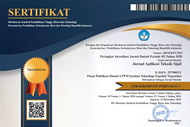Pemodelan Estimasi Biaya Kontingensi Pada Proyek Konstruksi Jalan Raya Berbasis Metode Analisis Risiko
Abstract
Keywords
Full Text:
PDFReferences
S. Akintoye and M. J. MacLeod, “Risk analysis and management in construction,” International Journal of Project Management, vol. 15, no. 1, pp. 31–38, 1997, doi: 10.1016/S0263-7863(96)00035-X.
S. Mak, J. Wong, and D. Picken, “The effect on contingency allowances of using risk analysis in capital cost estimating: A Hong Kong case study,” Construction Management and Economics, vol. 16, no. 6, pp. 615–619, 1998, doi: 10.1080/014461998371917.
D. Baccarini, “Estimating Project Cost Contingency - A Model and Exploration of Researc,” 20th Annual ARCOM Conference, vol. 1, no. September, pp. 105–13, 2004.
A. Idrus, M. Fadhil Nuruddin, and M. A. Rohman, “Development of project cost contingency estimation model using risk analysis and fuzzy expert system,” Expert Systems with Applications, vol. 38, no. 3, pp. 1501–1508, 2011, doi: 10.1016/j.eswa.2010.07.061.
J. F. Al-Bahar and K. C. Crandall, “Systematic risk management approach for construction projects By Jamal F. Al-Bahar 1 and Keith C. Crandall, 2 Member, ASCE,” Engineering, vol. 116, no. 3, pp. 533–546, 1991.
K. W. Chau, “The validity of the triangular distribution assumption in Monte Carlo simulation of construction costs: Empirical evidence from Hong Kong,” Construction Management and Economics, vol. 13, no. 1, pp. 15–21, 1995, doi: 10.1080/01446199500000003.
P. Bakhshi and A. Touran, “An overview of budget contingency calculation methods in construction industry,” Procedia Engineering, vol. 85, pp. 52–60, 2014, doi: 10.1016/j.proeng.2014.10.528.
J. I. Ortiz-González, E. Pellicer, and G. Howell, “Contingency management in construction projects: A survey of spanish contractors,” 22nd Annual Conference of the International Group for Lean Construction: Understanding and Improving Project Based Production, IGLC 2014, pp. 195–206, 2014.
S.-H. Jan and S. P. Ho, “Construction Project Buffer Management in Scheduling Planning and Control,” Proceedings of the 23rd International Symposium on Automation and Robotics in Construction, no. October 2006, 2017, doi: 10.22260/isarc2006/0158.
L. Para-González, C. Mascaraque-Ramírez, and A. E. Madrid, “Obtaining the budget contingency reserve through the monte carlo method: Study of a ferry construction project,” Brodogradnja, vol. 69, no. 3, pp. 79–95, 2018, doi: 10.21278/brod69305.
R. E. Adaurhere, I. Musonda, and C. S. Okoro, “Construction contingency determination: A review of processes and techniques,” International Conference on Construction in the 21st Century, pp. 1–11, 2019.
S. Theodoridis and S. Theodoridis, “Chapter 14 – Monte Carlo Methods,” Machine Learning, pp. 707–744, 2015.
B. A. Traynor and M. Mahmoodian, “Time and cost contingency management using Monte Carlo simulation,” Australian Journal of Civil Engineering, vol. 17, no. 1, pp. 11–18, 2019, doi: 10.1080/14488353.2019.1606499.
S.Poulter, “Monte Carlo Simulation in Environmental Risk Assessment--Science, Policy and Legal Issues,” RISK: Health, Safety & Environment (1990-2002), vol. 9, no. 1, p. 4, 1998.
DOI: http://dx.doi.org/10.12962%2Fj2579-891X.v20i3.14100
Refbacks
- There are currently no refbacks.

Jurnal Aplikasi Teknik Sipil by Pusat Publikasi Ilmiah LPPM Institut Teknologi Sepuluh Nopember is licensed under a Creative Commons Attribution-ShareAlike 4.0 International License
Based on work at https://iptek.its.ac.id/index.php/jats




